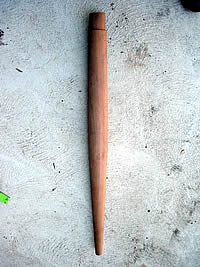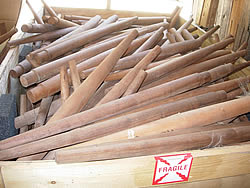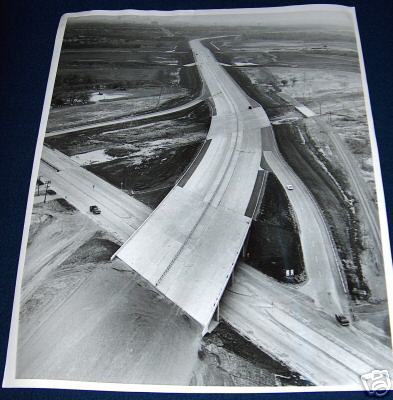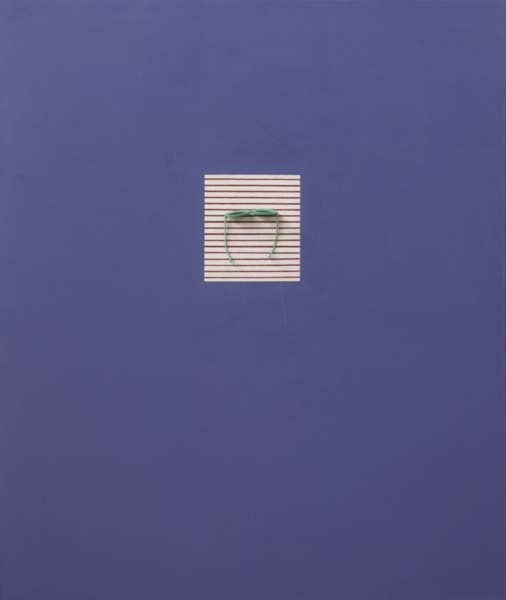Schwarz
View current page
...more recent posts
yeah, id wear it
As part of the new Bauhaus permanent exhibit in Dessau, Germany, the historic home of Wassily Kandinsky and Paul Klee is surprisingly sparse. Aside from a few photos of the middle-aged artists posing with rakish smiles, the unadorned, recently refurbished building where they once lived and worked serves as a testament to the movement's functional "design for living" philosophy. Nestled among pine trees alongside the half-dozen other Masters' Houses that architect and Bauhaus founder Walter Gropius built in the 1920s, the angular building features sprawling windows, spacious workshops, wine-red floors and pastel-green stairwells. It is the radiant symbol of an avant-garde movement whose activity was cut short—and one that people are now clamoring to rediscover.
my brother john has had the bug to get a silver western style cowboy belt buckle for ages. hes been checking the local flee markets and not finding the one. he just scored on ebay.
Alternately girlish and demonic, they merged popular culture, personal fantasy, history and current, often violent events and fell under the heading of scatter art, a phenomenon whose definition and membership remains a bit blurred. The artists most often identified with it — like Ms. Kilimnik, Sylvie Fleury, Cady Noland and, to some extent, Jessica Stockholder — are women, as are those artists’ most important precursors, among them Yvonne Rainer, Joan Jonas, Barbara Bloom and the photo-based generation grouped around Cindy Sherman. It could also be seen as including Felix Gonzalez-Torres, Jack Pierson and even Matthew Barney.
shaking all over ~ essential tremor
["The Electronic Spirit of Eric] satie [, featuring The Moog Synthesizer with The Camarata Contemporary Chamber Orchestra"] (mp3s)
don adams joke thief
great inside story on joke theft in general. but nowhere do they mention that the album cover art on "get smart!" is by mad magazine artist jack davis
In this four-minute outtake that didn’t make it into the final version of the documentary film Helvetica, designer Massimo Vignelli talks about his 1972 map of the New York subway system — which, you may recall, encountered stout opposition. Vignelli argues that, far from being too abstract, as the map’s detractors argued, his map wasn’t abstract enough: he should have left out the geographical references to waterways and parks, he thinks, leaving a blank background instead.
For the first eight episodes of Season 15, Bob Vila heads to the land of sun and fun: Miami Beach, Florida. He discovers that while most of glamorous "South Beach" has already been developed and real estate comes at a premium, there are still hot buys to be found north of the Deco District.
Just off the Venetian Causeway on a manmade island with gorgeous views of the Miami skyline and Biscayne Bay, he finds a small and very dated condo in a high-rise building and undertakes a high-style renovation. We learn about architect Morris Lapidus, the creator of the Fontainebleau and Eden Roc hotels and trendsetter for 1950's and '60s Miami Beach, and team up with the New York architectural/design team to the stars, Pierce Allen.
Bob shows how removing the popcorn ceiling and wall-to-wall carpet, knocking down walls to open up the space for today's lifestyle, and even refurbishing the existing 1960's aluminum slider and window puts this tired little apartment on the fast track into the next millennium. With glass tile, hip furnishings, custom glass pocket doors, fun curves, and a new take on using old-school products like cork flooring and laminates, this project is a breath of fresh air.
To: The Internet
From: carl@media.org for public.resource.org
Subj: smithsonianimages.si.edu
Date: May 19, 2007
We write to you today on the subject of SmithsonianImages.SI.Edu, a government ecommerce site built on a repository of 6,288 images of national significance. The site is breathtaking in scope, with imagery ranging from the historic cyanotypes of Edward Muybridge to historic photos from aviation, natural history, and many other fields. If the Smithsonian Institution is our attic, these photos are our collective scrapbook.
However, the web site imposes draconian limits on the use of this imagery. The site includes a copyright notice that to the layman would certainly discourage any use of the imagery. While personal, non-commercial use is purportedly allowed, it requires a half-dozen clicks before the user is allowed to download a low-resolution, watermarked image. An image without the watermark and at sufficient resolution to be useful requires a hefty fee, manual approval by the Smithsonian staff, and the resulting invoice specifically prohibits any further use without permission.
For some photos, the prohibitions go even farther. Aviation photos, for example, come from the National Air and Space Museum (NASM), which states, among other efforts to overreach, “even in the absence of copyright, Smithsonian still reserves all rights to image use.” Are these prohibitions on reuse valid? We showed the NASM copyright page to Yochai Benkler, a Yale law professor. Benkler wrote back that the unilateral and unequivocal claims were “nonsense on stilts.”
The Smithsonian Institution is a trust instrumentality of the United States of America chartered by the U.S. Congress to "increase and diffuse knowledge." 20 U.S.C. § 41 et seq. The Smithsonian's Board of Regents is chaired by the Chief Justice of the United States and the Institution receives over $650 million in federal funds every year.
To understand why the Smithsonian is over-reaching when it comes to photographs, one must remember that works of the U.S. government have no copyright protection whatsoever. Works of the United States Government are in the public domain. 17 U.S.C. § 105 While there are subtle exceptions, such as work prepared by private contractors exempted under special exemptions established in the Federal Acquisition Regulations ( FAR 52.227-14), the general principle is quite clear and applies just as much to the Smithsonian Institution as to any other part of our federal government. As Rachell V. Browne, Assistant General Counsel of the Smithsonian Institution said in a statement submitted to the U.S. Copyright Office:
“The Smithsonian cannot own copyright in works prepared by Smithsonian employees paid from federal funds.”
The Institution makes a great show of the distinction between “federal” employees and “trust” employees. But, this distinction is based on an obscure 1962 non-binding opinion [Application for Registration of Claim to Copyright Protection of Publication Entitled “The White House - An Historic Guide,” Op. Off. Legal Counsel (October 26, 1962)]. As a matter of policy it is difficult to conceive of two Smithsonians, a federal institution accountable to the American people and an ironically named "trust" somehow allowed to act as a private, opaque body accountable to only the whims of management. Even if one is to carve off a “private trust” with different rules from those that apply to agencies of the U.S. government, one must remember that the trust is registered under Section 501(c)(3) of the IRS Code and is thus required to perform actions that directly promote the declared charitable purpose, which in this case is to “increase and diffuse knowledge.”
Because the overwhelming majority of the images in SmithsonianImages.SI.Edu appear to be public domain, and because the draconian notices on the site have a dramatic chilling effect on use of these historic images and national symbols, we have performed several actions that we hope will allow others to examine the public domain status: continue
i suppose this guy thinks hes helping. what a knucklehead :
For a small city, St. Louis has an extraordinarily rich history of modernist architecture. Isadore Shank, William Adair Bernoudy, Harris Armstrong, Frederick Dunn, Charles Nagel, Ralph Cole Hall, Edouard Mutrux, Hank Bauer, and Eugene Mackey were all based here at one time or other. Most of their designs -- located in the wealthier, green and leafy suburbs west of the city -- were built during the golden age of St. Louis Modernism roughly between 1930 and 1970 when status was not to be distinguished solely on the square footage of a home.
Modernism, however, got a bad name due to its association with the soulless Internationalist Style of Ludwig "Less is More" Mies van der Rohe and Philip Johnson and their ubiquitous glass boxes designed for an urban population of automobiles and automatons rather than residents, tourists and shoppers. Being socialists first and architects second, Johnson and Mies were concerned mainly with political and social questions -- and thus built structures that reflected their vision of a workers' paradise -- as well as academic questions such as how to express the structure of a building externally. In the process, they forgot about the poor fish who would live and work among these sterile monstrosities.
Sadly they brought the same aesthetic to their domestic buildings, and nowhere was this more evident than in Johnson's Glass House and Mies' Farnsworth House. Historian Franz Schulze noted that the latter is "more nearly temple than dwelling, and it rewards aesthetic contemplation before it fulfills domestic necessity.�
However these domestic "temples" were the exception, not the rule. Unlike Mies's skyboxes, the bulk of modernist residential architecture was warm, open and organic, commingling brick, wood, stone and glass to create a sense of serenity which blurred the distinction between "inside" and "outside." Most important, they took into account the people who would live there. And unlike today's cookie cutter mansions, they were elegant and original. Was there ever a more breathtakingly beautiful home than Frank Lloyd Wright's Fallingwater, a home built not overlooking a waterfall, but over a waterfall.
The son of modernist Richard Neutra is looking for someone to buy and protect his father's last commercial building. It has been listed for sale for $3.5 million since November.
So far, Dion Neutra has had several offers, "but none that quite hit the nail on the head," he said in an e-mail. He insists that the National Register-listed building be sold with a protective conservation easement.
Built in 1950 as Neutra's office, the 4,800-square-foot building in Silver Lake, Calif., includes two apartments in the rear. Neutra wants to sell the building to establish an endowment to allow his Los Angeles-based Neutra Institute for Survial Through Design to continue.
inflate-o-pub
via j zoller
It seemed destined for the wrecking ball, like so many other midcentury buildings by the architect Paul Rudolph.
It wasn’t that the owners didn’t appreciate the sleek, rectangular house; they simply wanted a larger vacation home for the site, on a scenic bluff in Watch Hill, R.I.
two guys and a photograph
buy of the week, hammer price $450.00
Muriel
Wallace and Donahue (20th Century) Muriel, 1983; Oil and latex on canvas with sunglasses; Signed, dated and titled; 68" x 56"; Provenance: Margo Leavin Gallery, Los Angeles (label on verso); Private Collection
rubens tube
also via john zoller
ACME Klein Bottle
via j zoller
Over the last two decades as Mr. Serra’s work has become more and more sought-after by institutions and collectors, these kinds of installation scenes, worthy of the Army Corps of Engineers, have played out countless times around the world, with sculptures arriving by boat and truck at sites from Seattle to Spain to Qatar.
What he does do is design buildings that are uncommonly responsive to the environment in which they sit, to the indigenous physiognomy of the landscape, the angle of the sun, the path of the wind, the shapes of the leaves on the trees. By mixing together Australia’s vernacular style with the clean lines of classic Modernism, he has created an architecture that’s both true to the place and unexpectedly rigorous, like a bow and arrow made out of titanium. The recent widening of his reputation owes a lot to the profession’s gradual conversion to the gospel of environmentalism, but he remains stubbornly autonomous and openly wary of catchphrases and clichés. (Of “sustainable architecture” he noted: “Most of it is bloody awful. Much of it isn’t architecture, and some of it isn’t sustainable.”) But the Pritzker is a machine for star-making, and as a result, this most resolutely local of architects has slowly acquired an international profile.from this weeks nyt magazine eco-tecture issue
nice richard pettibone lot
squandered heritageNOLA -- We have written about the imminent danger list before. The difficulty in tracking this list is that there are simply too many properties listed to maintain an effective overight.
This spring, a plane-shaped piece of roadside architecture is preparing for takeoff.
Built as a Texaco gas station in 1930 in Powell, Tenn., the small building was falling down when a group formed four years ago. "It was self-destructing," says Rock Bernard, head of the Airplane Filling Station Preservation Association. "It had been abused. It had had little or no maintenance at all."
Now the nonprofit, hoping to create an office or visitors center, is fixing the plane's right wing and windows.
Despite the success of saving Johnson’s masterpiece, other less well-known Modernist buildings across the United States are now facing demolition. The main threat comes from skyrocketing land prices; these landmark buildings are prized more for their land than their architecture, say design curators and preservation experts nationwide. Barry Bergdoll, chief curator of architecture and design at MoMA, believes that for every Modernist structure saved, two are torn down and many are altered. Other experts believe the number of modernist buildings demolished could be considerably higher.
sonnenbrillen präzisionswerfen bei orschlurch.de - sonnebrille sonne
via jz
chernobyl at 21
via john zoller
Tiravanija’s redux of Untitled 1992 (Free) acts as a kind of invading organism that usurps the function of the gallery, displacing it with real life. All this is underscored by another recreation at Zwirner’s, next to Tiravanija’s. It is a signature piece of post-minimalist sculpture by the late Gordon Matta-Clark, made exactly 20 years before the Tiravanija, and as fate would have it, at the exact same address on Greene Street in SoHo where Tiravanija originally made Untitled 1992 (Free).
Nevelson was sui generis. Though a quintessential modernist, she was no joiner. During her long life of artistic activity, she studied Cubism, flirted with Surrealism, and imbibed the influence of Minimalism, but no avant-garde movement could claim her. She was Mark Rothko's favorite sculptor, but she wasn't hanging out with the Ab-Ex crowd at the Cedar Tavern. Jed Perl, who gives her short shrift in New Art City, his survey of mid-20th-century Manhattan's artistic avant-gardes, links her work with the sculptor Richard Stankiewicz's "junkyard Constructivism." But Stankiewicz (a generation younger) and David Smith (her nearer contemporary) were welders, while she worked with the regenerative capacities of wood, a once-living medium. And the room-size environments she began fabricating in the 1960s preceded the advent of installation art by some 20 years.
Tomorrow, the Maison Tropicale, a small aluminum-paneled house built in 1951 by Jean Prouvé, a French designer and the current court favorite of well-heeled contemporary art and design collectors internationally, is being opened to the public for preview in Long Island City. Christie’s, the auction house, will offer it for sale on June 5. The presale estimate is $4 million to $6 million.


george nakashima cherry wood table legs $20 each
An observation of the observations of Don Van Vliet by Anton Corbijn
farmhouse construction photos on yellow and white check tablecloth
pet monkey photos
Rock and roll, despite the reputation many of its artists have for mayhem and property destruction, has a surprising number of historic landmarks that didn't just survive—they thrive. Given rock and roll's status as a genuine, homegrown American product, like baseball it enjoys a growing number of wanderers who love hitting the road in search of the landmarks that define the art.

20c design poll
Matteo Pericoli has never felt compelled t keep his drawings to standard sizes. I 1998, he began drawing the entire perimeter o Manhattan on two thirty-seven-foot rolls of whit paper. (Pericoli, an architect who now work mainly as an artist, turned that drawing into hi first book, “Manhattan Unfurled.”) But there is n sheet, or scroll, or any other type of paper big enough for Pericoli’s lates drawing, which was commissioned for the new American Airlines terminal a John F. Kennedy International Airport. When it is done, it will be three hundre and ninety-seven feet long and will range from thirty to fifty-two feet in height The drawing fills a wall that runs the length of the entry hall of the new terminal and its shape reflects the terminal’s swooping rooflinepericoli google images
“At first, I played with the idea of using drawings that existed and blowing them up,” Pericoli, who is thirty-eight, said the other day. “And then I thought of putting buildings from cities I liked from all over the world into a single skyline.” Eventually, Pericoli came up with a composition that includes four hundred and fifteen buildings from seventy cities. He organized them by instinct, not geography. Hagia Sophia, in Istanbul, is next to the Burj Al Arab hotel, in Abu Dhabi, which is beside an old building in Buenos Aires, which is not far from a building that Frank Gehry designed in Prague. Pericoli balanced tall buildings with short ones, which meant that the Foshay Tower, in Minneapolis, looms over buildings lining a Venetian canal, and the curving tower of the Toronto City Hall gets to play against the curving roof of the Sydney Opera House. He also decided to add a building that never existed, an imaginary, Bauhaus-style structure by the artist Saul Steinberg. The one exception to the geographical mélange is a cluster of New York buildings at one end. Pericoli made this grouping to represent the notion that it is from New York that you fly off to see the rest of the world.
Pericoli’s freehand style is both precise and gentle: the buildings are meticulously detailed, but they are all washed with soft accents of blue and golden orange. Pericoli was as indifferent to scale as he was to geography. In his fantasy skyline, the Sears Tower, in Chicago, is smaller than the Brooklyn Bridge, and the Transamerica Pyramid, in San Francisco, is as high as the Eiffel Tower. “When you return from a journey to Rome, the Pantheon and the pizzeria occupy the same space in your memory,” he said.
When Pericoli was finished with the drawing, which was twelve and a half feet long, he sent it to a graphic-arts company in Chicago. The company blew the drawing up, and reproduced it digitally on vinyl material. The mural had to be divided into ninety-nine sections, each of which takes roughly two hours to print. The company has been shipping about twelve sections a day, three at a time, to J.F.K.
“Shoot” was one of a number of perfectly repellent performance pieces of the early nineteen-seventies in which Burden subjected himself to danger, thereby creating a double bind, for viewers, between the citizenly injunction to intervene in crises and the institutional taboo against touching art works. (Such, at any rate, was my analysis of the distinctive nausea that I felt in thinking of those things, which I avoided witnessing in person.) He spent five days in a small locker, with a bottle of water above and a bottle for urine below; slithered, nearly naked and with his hands held behind him, across fifty feet of broken glass in a parking lot; had his hands nailed to the roof of a Volkswagen; was kicked down a flight of stairs; and, on different occasions, incurred apparent risks of burning, drowning, and electrocution.
bottom feeding at the (quakertown pa) q-mart flee market
brian turners flickr page
The Schwarz
Outside the tourist zone, New Orleans remains a city of indolence and ruin. On the edges of the Central Business District, fires are erupting in abandoned buildings, at least three in the last week. The smoke curling under the highway overpasses has an ugly chemical smell. The Lower Ninth Ward is still mostly empty, vast and mute. But there is hustle and energy in the baking heat, in places like the parking slabs near Home Depot and Lowe’s, where Hispanic, black and a few white laborers gather every morning for work.
I came here to talk to day laborers, because I had been told that this was the worst place in America to be one. The money was good after Katrina, in August 2005, and the work pace was frantic. Men were recruited for jobs that were plentiful, though seldom as good as promised. Conditions were dangerous and sickening. A glut of workers soon lowered wages for everyone. Intimidation and abuse were common, often by contractors, sometimes by cops.
Some of the most celebrated levee repairs by the Army Corps of Engineers after Hurricane Katrina are already showing signs of serious flaws, a leading critic of the corps says.
The critic, Robert G. Bea, a professor of engineering at the University of California, Berkeley, said he encountered several areas of concern on a tour in March.
The most troubling, Dr. Bea said, was erosion on a levee by the Mississippi River Gulf Outlet, a navigation canal that helped channel water into New Orleans during the storm.
Breaches in that 13-mile levee devastated communities in St. Bernard Parish, just east of New Orleans, and the rapid reconstruction of the barrier was hailed as one of the corps’ most significant rebuilding achievements in the months after the storm.
images

Black & white aerial photo showing the construction of the East-West Expressway in Dallas, Texas. Date stamp on back says Mar 29 1962 Dallas Morning News, with a notation "East-West Expressway". This photo is in very good condition. No rips, tears, or creases.
hammer museum virtual tour
via jz
If you have an interest in either science or pop culture, you probably recall Biosphere 2, which briefly captured the world's fancy in 1991 when eight "biospherians" boldly went where no man or woman had gone before—into a giant terrarium for two years to live with plants, animals, and a whole lot of bugs. Their mission, driven by a strange philosophical meld of Star Trek and The Whole Earth Catalog, was going to show us everything from how to live in tune with nature here on earth to how we might someday exist on other planets.
It didn't work so well. The air inside the steel-and-glass enclosure went bad, cockroaches thrived, and the biospherians were constantly warding off hunger. Sometime after rumors spread that pizza and candy bars were being smuggled inside and that seven tons of oxygen had to be pumped in to keep them all breathing, Biosphere 2 became a national joke, a staple of late-night monologues and gleefully snarky reporters. By the time the eight biospherians were released back into the wild, the project had settled into a cultural niche as one of those goofy examples of self-aggrandizing counterculture idealism just made for a Saturday Night Live skit.
via justin
Kisho Kurokawa can’t seem to catch a break these days. Just days after the Japanese architect lost his bid for the governorship of Tokyo, the Nakagin Capsule Tower, his best known building and one of the few built examples of the Metabolist movement, was given a date with the wrecking ball.
The Capsule Tower, completed in 1972, stands in the center of Tokyo’s affluent Ginza neighborhood. The building is actually composed of two concrete towers, respectively 11 and 13 stories, each encrusted with an outer layer of prefabricated living units. It has long been appreciated by architects as a pure expression of the Metabolist movement, popular in the 1960s and 1970s, which envisioned cities formed of modular components. But in recent years residents expressed growing concern over the presence of asbestos. On April 15, the building’s management association approved plans calling for the architectural icon to be razed and replaced with a new 14-story tower. A demolition is yet to be determined.
tom warren visual journal #296
stills


